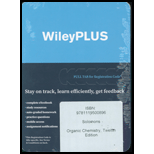
ORGANIC CHEMISTRY-WILEYPLUS ACCESS PKG.
12th Edition
ISBN: 9781119766919
Author: Solomons
Publisher: WILEY
expand_more
expand_more
format_list_bulleted
Concept explainers
Question
Chapter 6, Problem 14PP
Interpretation Introduction
Interpretation:
The given solvents are to be classified as protic or aprotic.
Concept introduction:
Protic solvents form hydrogen bonds. They contain a hydrogen atom bonded to an electronegative atom, such as oxygen or nitrogen, whereas aprotic solvents do not form hydrogen bonds.
Aprotic solvents are the solvents that do not form hydrogen bonds.
Expert Solution & Answer
Want to see the full answer?
Check out a sample textbook solution
Students have asked these similar questions
give example for the following(by equation)
a. Converting a water insoluble compound to a soluble one.
b. Diazotization reaction form diazonium salt
c. coupling reaction of a diazonium salt
d. indacator properties of MO
e. Diazotization ( diazonium salt of bromobenzene)
2-Propanone and ethyllithium are mixed and subsequently acid hydrolyzed. Draw and name the structures of the products.
(Methanesulfinyl)methane is reacted with NaH, and then with acetophenone. Draw and name the structures of the products.
Chapter 6 Solutions
ORGANIC CHEMISTRY-WILEYPLUS ACCESS PKG.
Ch. 6 - Prob. 1PPCh. 6 - Prob. 2PPCh. 6 - Prob. 3PPCh. 6 - Prob. 4PPCh. 6 - Prob. 5PPCh. 6 - PRACTICE PROBLEM 6.6
reactions that involve...Ch. 6 - PRACTICE PROBLEM 6.7 Rank the following...Ch. 6 - Prob. 8PPCh. 6 - Prob. 9PPCh. 6 - Prob. 10PP
Ch. 6 - Prob. 11PPCh. 6 - Prob. 12PPCh. 6 - Prob. 13PPCh. 6 - Prob. 14PPCh. 6 - Prob. 15PPCh. 6 - Prob. 16PPCh. 6 - Prob. 17PPCh. 6 - Prob. 18PPCh. 6 - Prob. 19PPCh. 6 - Prob. 20PCh. 6 - Prob. 21PCh. 6 - Prob. 22PCh. 6 - Prob. 23PCh. 6 - Prob. 24PCh. 6 - Listed below are several hypothetical nucleophilic...Ch. 6 - Prob. 26PCh. 6 - 6.27 Write conformational structures for the...Ch. 6 - 6.28 Consider the reaction of with .
(a) Would...Ch. 6 - Prob. 29PCh. 6 - Prob. 30PCh. 6 - Prob. 31PCh. 6 - Prob. 32PCh. 6 - 1-Bromobicyclo[2, 2,1] heptane is extremely...Ch. 6 - When ethyl bromide reacts with potassium cyanide...Ch. 6 - Prob. 35PCh. 6 - Prob. 36PCh. 6 - When the alkyl bromides (listed here) were...Ch. 6 - Prob. 38PCh. 6 - Prob. 39PCh. 6 - Prob. 40PCh. 6 - Prob. 41PCh. 6 - 6.42 The reaction of chloroethane with water in...Ch. 6 - Prob. 43PCh. 6 - Prob. 44PCh. 6 - Prob. 45PCh. 6 - Prob. 46PCh. 6 - 1-Bromo[2.2.1] bicycloheptane is unreactive toward...Ch. 6 - Open the computer molecular model tided...Ch. 6 - Prob. 49PCh. 6 - Consider the solvolysis reaction of (1S,...Ch. 6 - 2. Consider the following sequence of reactions,...
Knowledge Booster
Learn more about
Need a deep-dive on the concept behind this application? Look no further. Learn more about this topic, chemistry and related others by exploring similar questions and additional content below.Similar questions
- 3-Oxo-butanenitrile and (E)-2-butenal are mixed with sodium ethoxide in ethanol. Draw and name the structures of the products.arrow_forwardWhat is the reason of the following(use equations if possible) a.) In MO preperation through diazotization: Addition of sodium nitrite in acidfied solution in order to form diazonium salt b.) in MO experiment: addition of sodium hydroxide solution in the last step to isolate the product MO. What is the color of MO at low pH c.) In MO experiment: addition of sodium hydroxide solution in the last step to isolate the product MO. What is the color of MO at pH 4.5 d.) Avoiding not cooling down the reaction mixture when preparing the diazonium salt e.) Cbvcarrow_forwardA 0.552-g sample of an unknown acid was dissolved in water to a total volume of 20.0 mL. This sample was titrated with 0.1103 M KOH. The equivalence point occurred at 29.42 mL base added. The pH of the solution at 10.0 mL base added was 3.72. Determine the molar mass of the acid. Determine the Ka of the acid.arrow_forward
- As the lead product manager at OrganometALEKS Industries, you are trying to decide if the following reaction will its major product: 2,0° with a new C-C bond as If this reaction will work, draw the major organic product or products you would expect in the drawing aree below. If there's more than one major product, you can draw them in any arrangement you like. Be sure you use wedge and desh bonds if necessary, for example to distinguish between major products with different stereochemistry. If the major products of this reaction won't have a new C-C bond, just check the box under the drawing area and leave it blank.arrow_forwardwrite the mechanism of the nucleophilic acyl substitution reaction, please give an examplearrow_forwardThe compound in the figure is reacted with 10 n-butyllihium, 2° propanone, and 3º H2O. Draw and name the products obtained. SiMe3arrow_forward
- Caffeine (C8H10N4O2, pictured below) is a weak base. The pKb of caffeine is 10.4. What is the pH of a 0.0155 M solution of caffeine?arrow_forward2-Cyclopentyl-2-methyl-1,3-dioxolane is reacted with H₂SO₄. Draw and name the structures of the products.arrow_forwardIndicate the products of the reaction of 1-cyclohexyl-2,2-dimethylpropan-1-one with CH3CO3H (). Draw the structures of the compounds.arrow_forward
- Write chemical equations for: the reaction of benzoic acid chloride with grignard reagent [CH3MgX] the reaction of butanoic acid with methyl amine [CH3NH2]arrow_forward2-(3-Aminopropyl)cyclohexan-1-one is reacted with H₂SO₄. Draw the structures of the products.arrow_forwardPlease help me solve number 2arrow_forward
arrow_back_ios
SEE MORE QUESTIONS
arrow_forward_ios
Recommended textbooks for you
 Organic Chemistry: A Guided InquiryChemistryISBN:9780618974122Author:Andrei StraumanisPublisher:Cengage Learning
Organic Chemistry: A Guided InquiryChemistryISBN:9780618974122Author:Andrei StraumanisPublisher:Cengage Learning

Organic Chemistry: A Guided Inquiry
Chemistry
ISBN:9780618974122
Author:Andrei Straumanis
Publisher:Cengage Learning